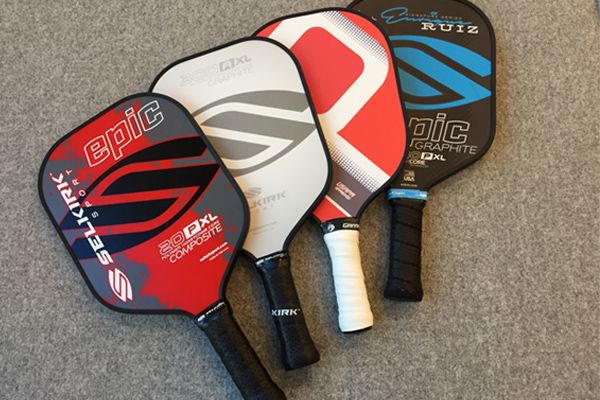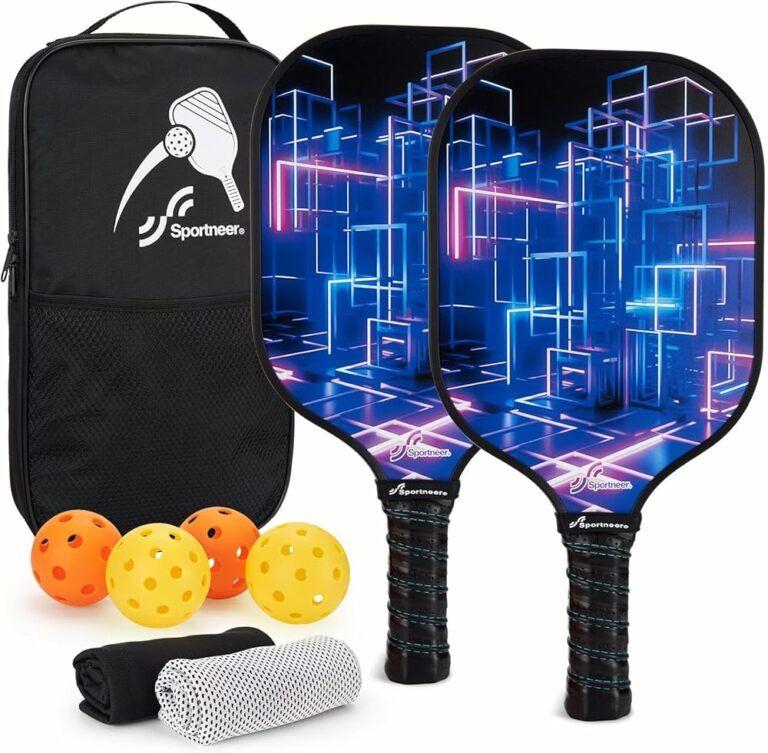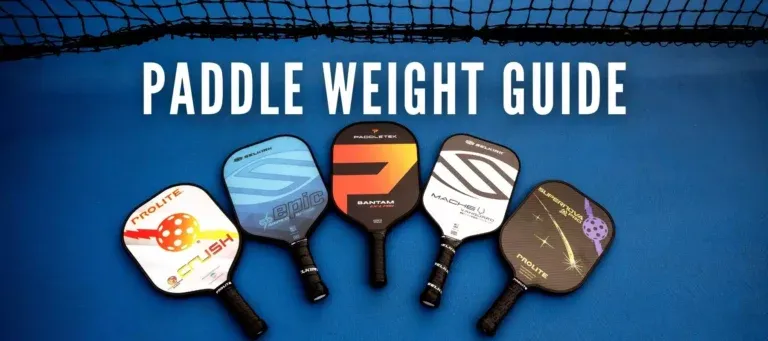Understanding the Basics: Paddle Anatomy and Materials
To appreciate the nuances between graphite vs composite pickleball paddles, it’s essential to understand their anatomy. A typical pickleball paddle comprises three main components: the face, the core, and the grip. Each of these parts significantly impacts the paddle's overall performance.
The face, or the hitting surface of the paddle, can be constructed from various materials that affect how the ball interacts with the paddle. For instance, materials like fiberglass and graphite play roles in enhancing power and control. The core, often made of a honeycomb structure, contributes to the paddle's weight, durability, and responsiveness, while the grip is essential for player comfort and control during play.
Moreover, players should note that paddles used in competitive settings must be approved by the USA Pickleball Association (USAPA). This ensures that the paddles meet specific performance and safety standards, vital for tournament play.

Composite Paddle Materials and Construction
Composite paddles are constructed using a blend of materials, typically including fiberglass, carbon fiber, and a polymer core. This amalgamation creates a robust paddle that strikes a balance between power and control. The outer surface of composite paddles is often layered with fiberglass, which enhances their durability while contributing to their power potential during play.
The design and construction of composite paddles allow for a textured surface, greatly impacting ball spin and overall control. Players who prioritize generating tempo and spin will likely benefit from the performance attributes of these paddles. Composite paddles may also incorporate a honeycomb core, enhancing their ability to absorb impact and improve shot responsiveness.
Graphite Paddle Materials and Construction
In contrast, graphite paddles are predominantly formed with a pure graphite face and a polymer or Nomex core. The solid construction of graphite contributes to a more consistent feel and higher sensitivity during play. This leads to quicker, more agile reactions that can be crucial in competitive settings.
Graphite paddles are noted for their sleek, lightweight design that allows players to swing with ease and enhance their maneuverability. The homogeneous nature of graphite paddles can result in precise energy transfer during impact, enabling more accurate shot placements. Players often find that these paddles provide a smoother experience that enhances ball control and touch.
Graphite vs Composite Pickleball Paddles: Advantages and Disadvantages
Advantages of Composite Paddles
- Versatility and Durability: One of the standout features of composite paddles is their mix of materials, which allows for versatility in performance. Their robust nature means they can handle considerable wear and tear, making them advantageous for players who play often.
- Spin Generation: The textured surface of composite paddles can enhance spin on the ball. This is particularly valuable for players who enjoy executing powerful spins or trick shots attributes that can change the dynamic of a game.
- Affordability: Composite paddles typically fall within a range of $50 to $200, making them accessible for beginners and recreational players. This cost-effectiveness does not necessarily translate to lower performance, as many composite paddles boast solid quality.

Disadvantages of Composite Paddles
- Weight: Generally, composite paddles are heavier than their graphite counterparts, averaging about 8.0 ounces. While some players may find that the weight adds power to their shots, it can lead to fatigue over long playing sessions, potentially affecting maneuverability.
- Durability vs. Graphite: Although composite paddles are durable, they might not withstand intense usage over time compared to graphite paddles, especially in competitive environments where high impact is common.
Advantages of Graphite Paddles
- Lightweight Design: One of the primary benefits of graphite paddles is their lightweight nature, which typically ranges from 6 to 9 ounces. This design allows for quicker swings and swift reactions, essential for competitive players who prioritize agility.
- Control: Graphite paddles excel in providing superior control and finesse. The material’s properties facilitate a responsive touch, crucial for players who focus on precise shot placement, be it during soft games or aggressive rallies.
- Reduced Strain: Players concerned about arm fatigue will benefit from the lightweight design of graphite paddles, which reduces tension during play. This can be especially significant for those experiencing shoulder or elbow issues, ensuring a comfortable playing experience.
Disadvantages of Graphite Paddles
- Price: The premium materials used in graphite paddles often lead to a higher price point. Prices can easily exceed $200 for high-end models, making them a larger investment for serious players.
- Skill Requirement: While graphites offer great benefits, they often require players to have a higher skill level for mastering techniques, such as spin serves. Beginners might find the learning curve a bit challenging compared to the more forgiving nature of composite paddles.
Key Performance Factors
Weight and Balance
When deciding between graphite vs composite pickleball paddles, weight plays a crucial role in performance. Composite paddles generally provide a heavier feel, which can translate to additional power behind shots. However, this added weight may also lead to increased arm strain over prolonged play. Conversely, graphite paddles’ lighter weight encourages quicker swings and less fatigue, enhancing overall performance.

Power vs. Control
The impact of material on power transfer is significant. Composite paddles offer a combination of strength and control, allowing players to execute robust shots while maintaining precision. In contrast, graphite paddles facilitate superior energy transfer that results in powerful shots without sacrificing touch, catering to players who focus on both power and control.
Spin Generation
Both paddle types exhibit unique properties affecting spin. Composite paddles often have a textured surface that enhances spin potential, making them ideal for players who want to incorporate top spin or slice into their game. Electing to maximize spin with a composite paddle is often simpler due to its design, while graphite paddles also offer spin capabilities, albeit with different techniques required for optimal results.
Durability and Longevity
Understanding paddle durability is vital for any player. Composite paddles, while robust, may have a shorter lifespan compared to graphite paddles, which are designed to endure heavy impacts. Players should consider how frequently they play and the intensity of their games when contemplating the durability of their chosen paddles. Proper storage and maintenance also play a significant role in prolonging paddle life.
Sound and Noise Levels
Noise restrictions in local communities can influence paddle choice, particularly where sound levels are regulated. Graphite paddles often produce a distinct “pop” sound upon impact that can be louder than composite paddles. Players in noise-sensitive areas should consider this factor when making their selection.
Choosing the Right Paddle for Your Playing Style
When selecting between graphite vs composite pickleball paddles, players should reflect on their individual playing styles and goals.

For Power and Spin Players
Players who value power and spin generation should consider composite paddles. The textured surface and solid construction allow for enhanced spin and a punchy feel during play. Composite paddles are suited for players who enjoy executing aggressive shots and tricks, adding an exciting dynamic to their game.
For Control and Finesse Players
Conversely, if your focus lies on control, handling, and precision, graphite paddles might be the better choice. The lightweight design enables quick reactions, and the exceptional feel provides better accuracy. This makes graphite paddles particularly appealing for players looking to finesse their shots and master strategic gameplay.
Addressing Specific Needs and Concerns
Health and Injury Prevention
Paddle weight significantly impacts arm strain and the potential for injuries, such as tennis elbow. Ergonomic considerations in paddle design can enhance comfort and alleviate stress during play. Players should evaluate paddle weight alongside their physical condition to mitigate the risk of fatigue or strain-related injuries.
Grip and Ergonomics
The grip size, length, and material of a paddle can profoundly influence comfort and control during play. Players employing two-handed backhands should consider their grip preferences to ensure optimal performance. Comfort in the grip allows for a confident hold on the paddle, enhancing overall gameplay.
Beyond Composite and Graphite: Other Paddle Materials
Carbon Fiber Paddles
Carbon fiber paddles have begun gaining traction in the pickleball world. They offer a unique blend of strength and lightweight properties, potentially appealing to players who want the best of both worlds. While not as common as composite or graphite paddles, carbon fiber presents an intriguing option for those exploring alternatives.
Wood Paddles
Wood paddles, while effective for beginner training, are often less favored by regular players due to their weight and limitations regarding performance. The rigid nature of wood can hinder spin and control, making it unsuitable for serious competition. However, they can still serve as a cost-effective option for casual play.
Testing and Trying Paddles Before You Buy
Before investing in a paddle, it's crucial to try out both types to see which one aligns with your preferences. Visiting sporting goods stores or local pickleball clubs often allows players to demo various paddles firsthand. This experience can provide insight into the weight, feel, and performance characteristics that may suit your playing style best.
Final Recommendations
In conclusion, the distinction between composite and graphite pickleball paddles comes down to individual player preferences, playing style, and budget. Composite paddles present an ideal solution for beginners and recreational players seeking durability and affordability, while graphite paddles cater to the serious player focused on precision and power. By understanding the differences and advantages of each type, you can select a paddle that enhances your performance and overall enjoyment on the court.










